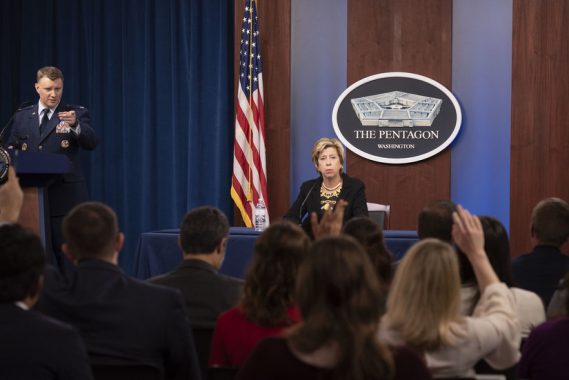Disrupting Acquisition Blog
USD(A&S) Ellen Lord On Acquisition Reforms and Innovation
On 26 Aug 2019, Ms. Ellen Lord, Under Secretary of Defense for Acquisition and Sustainment had a press briefing on Acquisition Reform and Innovation. Here are some highlights.

Photo by Petty Officer 2nd Class James Lee
The A&S mission is enabling the delivery and sustainment of secure and resilient capabilities to the warfighter and international partners quickly and cost-effectively.
Under this mission are six A&S goals supported by priorities in each.
- Recruit, develop and retain a diverse acquisition and sustainment workforce. We want to modernize the acquisition workforce talent, management tools and processes, as well as deliver content consistent with adult learning. A great example of this modernization is the TEDx DAU event recently held at Fort Belvoir.
- Enable acquisition innovation. Create, train and implement the adaptive acquisition framework. For example, the rewrite of 5000 and development of software pathways. Enable contracting at the speed of relevance. In other words, be creatively compliant to use the simplest acquisition authority and contract type possible.
- Build a safe, secure and resilient defense industrial base. Address impacts of prohibited foreign investments. On the defensive side, we have CFIUS, Countering Foreign Investment in the U.S., and FIRRMA, Foreign Investment Risk Review Modernization Act. However, I want to go on the offense. We’re going to do this with a trusted capital marketplace.
- Ensure safe and resilient DOD installations. Enhance the quality of military housing, ensure installation energy resilience, and cyber-secure our facilities.
- Increase weapons system mission capability while reducing operating costs. Under this, improve F-35 execution, development, production and sustainment. Enhance weapons systems’ cyber-resiliency.
- Promote acquisition and sustainment initiatives with key international partners. Enable timely foreign military sales deliveries via contracting, dialogue with industry, tech release and plans for exportability. Partner with inter-agency and industry stakeholders to advance shared equities.
I’d like to highlight some of our accomplishments.
- Middle Tier of Acquisition. Since November 2018, we have expanded from zero to more than 50 programs. We’re scheduled to publish formal policy in December, and I’m happy that we’re seeing positive results for our warfighters, taking an average of over two years out of each of the programs.
- Software acquisition and practices report. In cooperation with the CIO, the DOD Enterprise DevSecOps Reference Design was released this month. This guide provides implementation and operational guidance to all DOD components to allow them to immediately adopt modern software development practices and speed the delivery of high-quality, secure and effective warfighting software capability to match the speed of operations.
- A&S is now issuing new functional policies on mission engineering and intellectual property and assisting with the re-issuance of several other functional policies. By October 2019, we expect to formally stand up an OSD intellectual property cadre to develop DOD policy within the whole-of-government effort to address concerns on data rights.
- Rewrite DOD 5000.01 and DOD Instruction 5000.02 with the goal of having signed policy by December 2019.
- Acquisition innovation: DOD acquisition is known for being expensive, with excessive cost overruns; slow, many years from R&D until capability is provided to the warfighter, and burdensome, with over-regulation of services and industries. Successful implementation of these acquisition change efforts will reduce timelines, lower costs and improve quality while rapidly introducing new technology to enhance capability for our warfighters. As we continue to leverage other transaction authorities in middle tier, as I mentioned earlier, we will continue to make a very significant difference. DOD acquisition innovation is being implemented within four broad categories:
- Restructuring acquisition, policy and governance
- Contracting at the speed of relevance. We have seen a 15% reduction of clauses in the DFARS, from 352 to 298, a 60% reduction in DFARS publication backlog, from 128 to 50, and a 50% reduction in procurement administrative lead time, from 32 to 16 months for multiple pathfinder projects.
- Strengthening and securing the defense industrial base
- Effective training of the acquisition workforce.
- To secure the DOD supply chain, the department is creating theCybersecurity Maturity Model Certification, CMMC program, in collaboration with Johns Hopkins Applied Physics Lab and Carnegie Mellon Software Engineering Institute, as well as industry.
- The CMMC establishes security as the foundation to acquisition, and combines the various cyber-security standards into a unified standard.
- The CMMC framework will be made fully available in January 2020
- By June 2020, industry will see CMMC requirements as part of requests for information.
- By fall of 2020, CMMC requirements will be included in requests for proposals and will be a go/no go decision.
- Trusted Capital Marketplace Program, this is a public-private partnership that will convene trusted sources of private capital with innovative companies critical to the defense industrial base and national security.
- Since we last met, we stood up our team to manage both capital vetting requirements and industry outreach and matching efforts.
- We have identified the first industry sector target goals, and we hope to have an industry outreach event in October which will focus on small UAS.
- I can’t provide any details on dollar amount or company names or numbers, but I’m encouraged we’re moving forward.
See also: USD(A&S) Strategy Roadmap
Disclaimer: The opinions expressed here are those of the authors only and do not represent the positions of the MITRE Corporation or its sponsors.
Subscribe to Our Newsletter


0 Comments